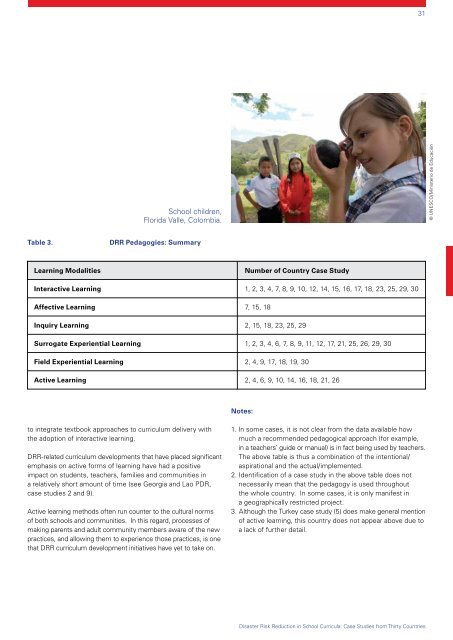Disaster Risk Reduction in School Curricula: Case Studies ... - Unicef
Disaster Risk Reduction in School Curricula: Case Studies ... - Unicef
Disaster Risk Reduction in School Curricula: Case Studies ... - Unicef
Create successful ePaper yourself
Turn your PDF publications into a flip-book with our unique Google optimized e-Paper software.
31<br />
<strong>School</strong> children,<br />
Florida Valle, Colombia.<br />
© UNESCO/M<strong>in</strong>isterio de Educación<br />
Table 3.<br />
DRR Pedagogies: Summary<br />
Learn<strong>in</strong>g Modalities<br />
Interactive Learn<strong>in</strong>g<br />
Affective Learn<strong>in</strong>g<br />
Inquiry Learn<strong>in</strong>g<br />
Surrogate Experiential Learn<strong>in</strong>g<br />
Field Experiential Learn<strong>in</strong>g<br />
Active Learn<strong>in</strong>g<br />
Number of Country <strong>Case</strong> Study<br />
1, 2, 3, 4, 7, 8, 9, 10, 12, 14, 15, 16, 17, 18, 23, 25, 29, 30<br />
7, 15, 18<br />
2, 15, 18, 23, 25, 29<br />
1, 2, 3, 4, 6, 7, 8, 9, 11, 12, 17, 21, 25, 26, 29, 30<br />
2, 4, 9, 17, 18, 19, 30<br />
2, 4, 6, 9, 10, 14, 16, 18, 21, 26<br />
Notes:<br />
to <strong>in</strong>tegrate textbook approaches to curriculum delivery with<br />
the adoption of <strong>in</strong>teractive learn<strong>in</strong>g.<br />
DRR-related curriculum developments that have placed significant<br />
emphasis on active forms of learn<strong>in</strong>g have had a positive<br />
impact on students, teachers, families and communities <strong>in</strong><br />
a relatively short amount of time (see Georgia and Lao PDR,<br />
case studies 2 and 9).<br />
Active learn<strong>in</strong>g methods often run counter to the cultural norms<br />
of both schools and communities. In this regard, processes of<br />
mak<strong>in</strong>g parents and adult community members aware of the new<br />
practices, and allow<strong>in</strong>g them to experience those practices, is one<br />
that DRR curriculum development <strong>in</strong>itiatives have yet to take on.<br />
1. In some cases, it is not clear from the data available how<br />
much a recommended pedagogical approach (for example,<br />
<strong>in</strong> a teachers’ guide or manual) is <strong>in</strong> fact be<strong>in</strong>g used by teachers.<br />
The above table is thus a comb<strong>in</strong>ation of the <strong>in</strong>tentional/<br />
aspirational and the actual/implemented.<br />
2. Identification of a case study <strong>in</strong> the above table does not<br />
necessarily mean that the pedagogy is used throughout<br />
the whole country. In some cases, it is only manifest <strong>in</strong><br />
a geographically restricted project.<br />
3. Although the Turkey case study (5) does make general mention<br />
of active learn<strong>in</strong>g, this country does not appear above due to<br />
a lack of further detail.<br />
<strong>Disaster</strong> <strong>Risk</strong> <strong>Reduction</strong> <strong>in</strong> <strong>School</strong> <strong>Curricula</strong>: <strong>Case</strong> <strong>Studies</strong> from Thirty Countries

















